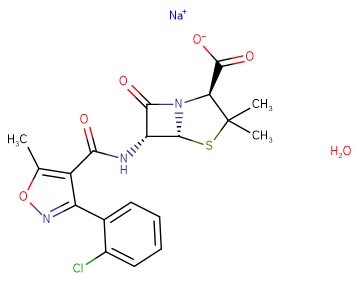
Cloxacillin sodium monohydrate
CAS No. 7081-44-9
Cloxacillin sodium monohydrate( —— )
Catalog No. M15717 CAS No. 7081-44-9
Cloxacillin sodium (Cloxacap) is a sodium salt of cloxacillin that is a penicillinase-resistant, acid resistant, semi-synthetic penicillin.
Purity : >98% (HPLC)
 COA
COA
 Datasheet
Datasheet
 HNMR
HNMR
 HPLC
HPLC
 MSDS
MSDS
 Handing Instructions
Handing Instructions
| Size | Price / USD | Stock | Quantity |
| 50MG | 32 | In Stock |


|
| 100MG | 43 | In Stock |


|
| 200MG | 52 | In Stock |


|
| 500MG | 71 | In Stock |


|
| 1G | Get Quote | In Stock |


|
Biological Information
-
Product NameCloxacillin sodium monohydrate
-
NoteResearch use only, not for human use.
-
Brief DescriptionCloxacillin sodium (Cloxacap) is a sodium salt of cloxacillin that is a penicillinase-resistant, acid resistant, semi-synthetic penicillin.
-
DescriptionCloxacillin sodium (Cloxacap) is a sodium salt of cloxacillin that is a penicillinase-resistant, acid resistant, semi-synthetic penicillin. Cloxacillin sodium exerts a bactericidal action against susceptible microorganisms during the stage of active multiplication. Cloxacillin sodium acts through the inhibition of biosynthesis of cell wall mucopeptides.(In Vitro):Cloxacillin sodium monohydrate (0-2048 μg/mL; 20-24 h) shows good antibacterial activity for S. aureus 8325-4 and DU1090 with MIC values both of 0.125 μg/mL.Cloxacillin sodium monohydrate (0.015625 μg/mL; 6 h) inhibits the hemolytic activity of Hlα in vitro, and this inhibition is not only more pronounced when combined with TZ and TZ, but also suppresses the inflammatory response by inhibiting the activation of MAPKs, NF-кB and NLRP3-related proteins.(In Vivo):Cloxacillin sodium monohydrate (1.6125 mg/kg; s.c.; 12-h intervals for 72 h) protects mice from S. aureus peritonitis in vivo when combines with Thioridazine and Tetracycline.Cloxacillin sodium monohydrate (7.5 mg/per; i.p.; twice daily from day 3 for 3 days) develops less severe synovitis and reduces bone erosions when combines with anti-IL-15 antibodies.
-
In VitroCloxacillin sodium monohydrate (0-2048 μg/mL; 20-24 h) shows good antibacterial activity for S. aureus 8325-4 and DU1090 with MIC values both of 0.125 μg/mL.Cloxacillin sodium monohydrate (0.015625 μg/mL; 6 h) inhibits the hemolytic activity of Hlα in vitro, and this inhibition is not only more pronounced when combined with TZ and TZ, but also suppresses the inflammatory response by inhibiting the activation of MAPKs, NF-кB and NLRP3-related proteins. Cell Viability Assay Cell Line:S. aureus 8325-4, S. aureus DU1090 (an Hlα-deleted strain)Concentration:0-2048 μg/mL Incubation Time:20-24 h Result:Inhibited S. aureus 8325-4 and DU1090 with MIC values both of 0.125 μg/mL.
-
In VivoCloxacillin sodium monohydrate (1.6125 mg/kg; s.c.; 12-h intervals for 72 h) protects mice from S. aureus peritonitis in vivo when combines with Thioridazine and Tetracycline.Cloxacillin sodium monohydrate (7.5 mg/per; i.p.; twice daily from day 3 for 3 days) develops less severe synovitis and reduces bone erosions when combines with anti-IL-15 antibodies. Animal Model:Female BALB/c mice (6-week-old; peritonitis model).Dosage:1.6125 mg/kg (combines with TC (3.125 mg/kg) and TZ (25 mg/kg)) Administration:Subcutaneous injection; 12-h intervals for 72 h.Result:Reduced the degree of inflammatory cell infiltration in the mouse lung tissue and alveolar structures tended to be normal.Significantly reduced the pathological changes in spleen and liver tissue, as well as decreased the CFU counts of S. aureus in the peritoneal cavity.Animal Model:Female wildtype C57BL/6 mice (8-week-old; systemic S. aureus-induced arthritis model)Dosage:7.5 mg/per (combines with 25 μg/per anti-IL-15 antibodies) Administration:Intraperitoneal injection; twice daily from day 3 (after bacterial inoculation) and stopped at day 6.Result:Showed activities of reducing severe synovitis and bone erosions when combined with anti-IL-15 antibodies.
-
Synonyms——
-
PathwayOthers
-
TargetOther Targets
-
RecptorOthers
-
Research AreaInfection
-
Indication——
Chemical Information
-
CAS Number7081-44-9
-
Formula Weight475.88
-
Molecular FormulaC19H17ClN3NaO5S·H2O
-
Purity>98% (HPLC)
-
SolubilityEthanol: 25 mg/mL (52.53 mM); Water: 55 mg/mL (115.57 mM); DMSO: 55 mg/mL (115.57 mM)
-
SMILESCC1=C(C(=NO1)C2=CC=CC=C2Cl)C(=O)N[C@H]3[C@@H]4N(C3=O)[C@H](C(S4)(C)C)C(=O)[O-].O.[Na+]
-
Chemical Name——
Shipping & Storage Information
-
Storage(-20℃)
-
ShippingWith Ice Pack
-
Stability≥ 2 years
Reference
1.Roy DK, et al. Spectrochim Acta A Mol Biomol Spectrosc. 2005 Jul;61(9):2017-22.
molnova catalog



related products
-
2-Chlorobenzene-1,3,...
2-Chlorobenzene-1,3,5-triol is a marine derived natural products found in Rhabdonia verticillata.
-
Trans-ACBD
1-Aminocyclobutane-1, 3-dicarboxylic acid is an effective and specific N-methyl-D-aspartate receptor agonist.
-
Benoxacor
Benoxacor is an inert agricultural chemical. Benoxacor acts as an herbicide safener to protect crops from herbicide toxicity.



 Cart
Cart
 sales@molnova.com
sales@molnova.com


